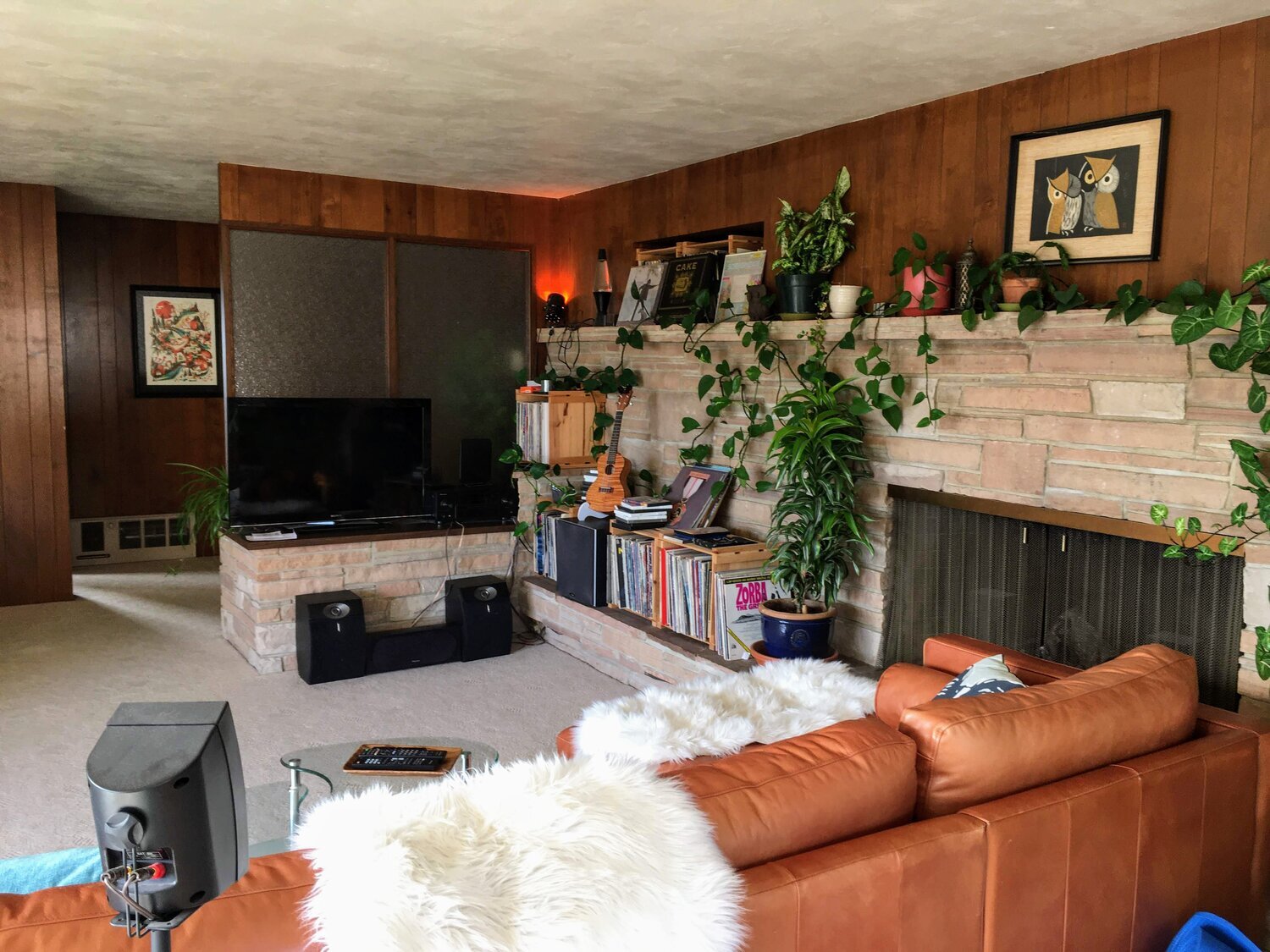Create a maximum happiness living room
Quick — right this minute — what does your living room look like?
If you’re like many people, it’s a cluttered way station for laundry, tech equipment and unfinished projects. There’s furniture that’s worn, uncomfortable or out of scale — in colors that bore you. It has inadequate lighting. (Or prison lighting!) Maybe it’s decorated with guilt gifts and art that’s just not your style.
As one of the most-used rooms in your house, changing up your living space can make a hugely positive impact on your life.
Fix it once.
Savor the daily joys forever.
In this blog post:
Our sad, cavernous cave
Don’t just settle for blah
Do it cheap or free
The 3 jobs of every living room
8 design tips you can use right away
Our sad, cavernous cave
When my husband and I first got together and I moved into his house, the living room felt like an abandoned conference room.
With furniture hugging the walls, the large space was echo-y and unsettling, with no obvious place to nestle in and chill.
Over several years, we went through a few iterations of furniture arrangements. The room gradually got better, especially after the purchase of a large, hulking, sectional couch that could at least hold a truckload of teenagers and adults watching a movie.
But it wasn’t until we moved the Dark Brown Behemoth sectional to the basement family room that it all came together.
Two lucky Craigslist couch finds led us to our current configuration below.
Now, we both absolutely love this room.
(Japanese owl print that has personal significance for my husband and me.
Fireplace is blocked because using it fills the basement with smoke!)
Don’t just settle for blah
If you don’t currently love your living room too, you’re missing a great opportunity.
A living room that just works can help you:
feel closer to the people you love
recharge your batteries after a long day
give you a little dopamine hit of joy every time you walk through it
Wouldn’t it be worth putting in a little conscious effort now to automatically reap those benefits later?
Consider too that a lot of our habitual behaviors are prompted by our environment. What unwanted habits are being reinforced by your current living space?
On the flip side, how could your environment support changes you want to make?
(An example of an unloved space with some likely well-intentioned, “temporary” problems.)
Do it cheap or free
Before you start thinking, This all sounds really expensive... Just know that you can transform your space by:
reusing and rearranging what you already have
adding a few inexpensive or used items.
I’ll illustrate these ideas with more detailed pictures from our house. Everything in our living room came from:
Craigslist
thrift stores
garage sales
Facebook Marketplace
Amazon
IKEA
Here’s what the room looks like (below) from the front door entry. Head-on, it’s definitely not magazine-perfect with crisp horizontal lines, but who cares? Nobody lives like that in real life anyway.
The whole point is to increase the levels of practical happiness.
So… good enough!
(Craigslist leather couch, Amazon coffee table, thrift store side table ($15!) and faux sheepskins for the pups. They follow the sun every morning but are hard to see in this lousy cell phone pic. My husband has the green thumb.)
The 3 jobs of every living room
There are three main jobs that a welcoming, functional living room has to perform. Miss any one of these and you’ll feel hampered, but may not consciously know why.
Your room has to provide the heavy lifting for three very different activities:
A place for visitors to sit down
A place to relax and be entertained (with your partner, family or friends)
A place to sit alone and read, write or do some kind of focused activity.
For smaller rooms, these will all happen in the same space. And yes, I realize we have two advantages going for us that some homes may not have (a large picture window and square footage) thanks to life in a ranch house. Nevertheless, these same principles still apply.
Let’s look at each job separately…
1. A place for visitors to sit down.
You’ll want to be able to turn toward each other, which means either two couches or chairs facing each other, an L-shaped seating arrangement, or two chairs “capping” the couch, like we have here.
(Craigslist couch, chairs and coffee table. Ikea and Amazon side tables and pillow cases. Paintings from family, one showing my husband and brother-in-law as children, another from an inspiring distant relative.)
2. A place to relax and be entertained
My husband and I like to curl up and watch a movie or TV together. When family’s over, there’s still enough room for us to all pile up like sardines and maybe even add some pull-up chairs to the side.
(This couch isn’t really conducive to conversation, since it only faces the TV. Visitors seem to instinctively head for the other seating area.)
3. A place to sit alone and read, write or do some focused kind of activity.
I think of this spot below as my Reading & Learning Corner, because I keep books here that I’m actively studying. A journal and pen are always handy too.
($100 super comfy Goodwill chair, IKEA side table, Amazon bookshelf, garage sale blue lamp. One of my favorite places to read to my young granddaughter when she visits.)
8 design tips you can use right away
Here are some things I hold loosely in the back of my mind when I’m arranging a space...
There are no hard and fast rules here. Just use your best judgment for what feels balanced and pleasing to your eye… and feels good when you try it out.
(You don’t have to buy anything extra if you don’t want to. Have fun! Make it a scavenger hunt and pull stuff from other rooms.)
1. Make each sitting area complete.
This is such an important tip, it gets extra bullets! For every place to sit down, make sure you have access to:
A reachable place for drinks or snacks
Room for a book, phone or laptop
A way to prop your feet up if you’ll be sitting for a long time.
(Every person has a table in front of them or to the side. Shorter people have to stretch to prop their feet up if they’re in the orange chairs.)
2. Display only truly meaningful objects.
Use art, photos and knick-knacks that remind you of loved ones, adventures, family stories and talents.
Ask yourself: do your decorations still fit the you that you are now? Who you want to be in the future? If not, let them go…
Pass on any “guilt gifts” to someone else who would appreciate them or Goodwill. Take a picture first to ease the angst.
(Japanese prints by the same artist that did the owl print over the fireplace.)
3. Find colors that energize you.
Even if they’re weird — maybe especially if they’re weird!
If you feel stumped by what goes together, use a color wheel to figure out complementary pairings for pillows, blankets, curtains and furniture.
Luscious textiles also up the hygge, or coziness, factor.
Just like with purses or shoes, it can be helpful to think of combinations that go together in the black or brown color families. (Brown: orange, green, blue. Black: red, yellow, tan, etc.)
(Right across from teal is orange! You can also use shades that are close enough and not exact.)
4. Claim and master negative space.
Instead of hugging the walls, boldly place the heaviest furniture in the middle to create a mini-room.
Help seating areas feel protected and restful by adding an end table.
Minimize sharp corners in traffic paths (although I did break this rule below because there was plenty of space around the end table).
(Having the couch jut out into the room like this creates a U-shaped space for traffic flow. It also helps create 3 separate mini-rooms.)
5. Play with repetition.
Echo shapes, colors, textures and collections. You can repeat loosely matched pairings of:
the complementary shades you’ve chosen
basic shapes (like round tables)
textures (like silky velvet, bunchy wool or soft cotton)
and themes for objects (like owls and other animals).
Just distribute them around the room and somehow they’ll all seem linked.
(A tiny owl hiding amongst the leaves. A glass coaster made by a dear friend just happens to be orange.)
6. Use soft, warm lights.
They’ll fill a room with that indefinable cozy feeling, especially activity areas.
Use orange or yellow lights for a warmer, more relaxing mood and blue-ish light bulbs where you need energy and focus, like on a desk.
Make sure there aren’t any “dead” corners by adding inexpensive accent lights.
(Even the corner has a little fill light. A plant hides tangled cords behind the TV and stereo.)
7. Clear all horizontal surfaces.
If you struggle with this one, you’re not alone.
The key is to create little homes (in baskets, trays or boxes) for orphans like charging cords, remotes, projects in progress, etc.
Do a five-minute, clean sweep every night so a fresh room greets you the next day.
Let the container be the mess, not the whole room!
(A big basket holds a yoga mat and straps. The glass coffee table in front of the couch has a simple wooden plate we scrounged up from the kitchen for TV and stereo remotes.)
8. Add vibrance and life with plants.
Grow some plants that are hard to kill and propagate new ones (it’s fun!) to save money.
A year later you may find yourself with a beautiful indoor jungle.
Golden pothos, spider plants and bamboo are easy to tend. There are tons of houseplant resources online.
(We keep adding more plants! We’re creating starts from the giant monstera on the right.)
A room that can dramatically change your life
A living room that feeds your soul has the potential to make you happy every time you walk through it, giving you a little boost of happiness.
(Where we sit to have our coffee or tea every morning and watch the sun come up over the hills. This was an especially foggy day — even for Oregon.)
You can use your living space to:
Forget about the regular challenges of life and just kick back and relax….
Delight your senses with color and life.
Observe the outside world from a place of security and safety.
Create rituals to help you honor the time of day and changing seasons.
And most importantly, reconnect with your partner, family, friends and pets.
(Gigi and Vienna, our beloved mongoose yard cows.)
Good luck and have fun creating a living room you love!
If you have any questions, please let me know below….






















